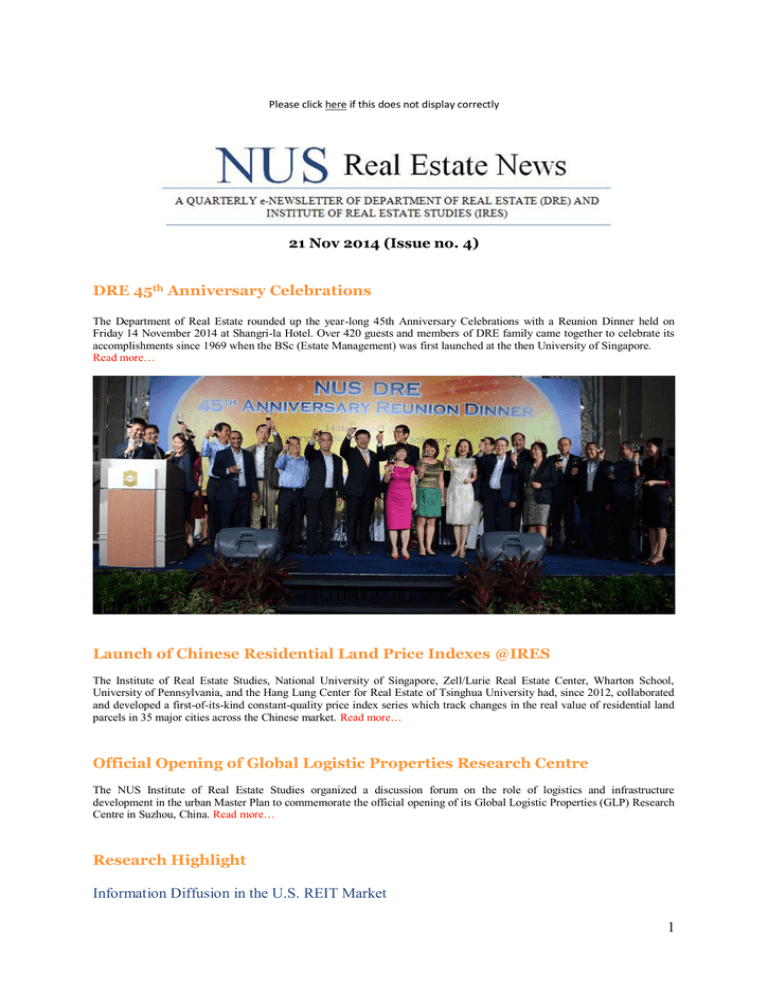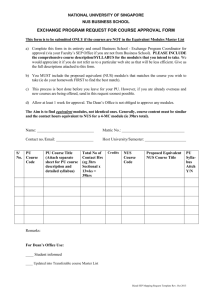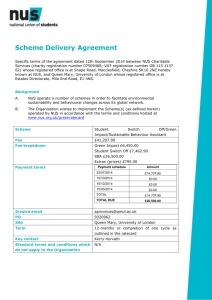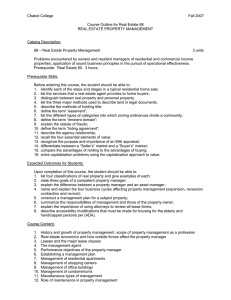DRE 45 Anniversary Celebrations 21 Nov 2014 (Issue no. 4)
advertisement

Please click here if this does not display correctly 21 Nov 2014 (Issue no. 4) DRE 45th Anniversary Celebrations The Department of Real Estate rounded up the year-long 45th Anniversary Celebrations with a Reunion Dinner held on Friday 14 November 2014 at Shangri-la Hotel. Over 420 guests and members of DRE family came together to celebrate its accomplishments since 1969 when the BSc (Estate Management) was first launched at the then University of Singapore. Read more… Launch of Chinese Residential Land Price Indexes @IRES The Institute of Real Estate Studies, National University of Singapore, Zell/Lurie Real Estate Center, Wharton School, University of Pennsylvania, and the Hang Lung Center for Real Estate of Tsinghua University had, since 2012, collaborated and developed a first-of-its-kind constant-quality price index series which track changes in the real value of residential land parcels in 35 major cities across the Chinese market. Read more… Official Opening of Global Logistic Properties Research Centre The NUS Institute of Real Estate Studies organized a discussion forum on the role of logistics and infrastructure development in the urban Master Plan to commemorate the official opening of its Global Logistic Properties (GLP) Research Centre in Suzhou, China. Read more… Research Highlight Information Diffusion in the U.S. REIT Market 1 This study examines the information diffusion process in the U.S. Real Estate Investment Trust (REIT) market with a focus on the impacts of changing market environments, information supply, and information demand on the lead-lag effect. Read more… Residential Relocation Decisions: The Role of Neighborhoods, Housing Tenure Choice, and Race Households are likely to consider moving from one neighborhood to another within the same city, defined as residential mobility, when they are not satisfied with their current neighborhoods. Understanding household residential mobility is important because it has a substantial impact on the surrounding neighborhood and the welfare of household members, especially children. Read more… Market Updates Singapore Residential Price index (SRPI) The NUS SRPI flash overall value weighted index in September dropped by 0.7 percent from the previous month. The NUS SRPI flash sub-indices for central region and non-central region in September also decreased by 0.9 percent and 0.6 percent respectively from August. The NUS SRPI sub-index for small units was the only one that rose in September by 0.4 percent from the previous month. Read more… NUS-REDAS Real Estate Sentiment Index (RESI) Real Estate Developers’ sentiment of the market remains weak in 3Q14. The Composite Sentiment Index, a derived indicator for the overall real estate market sentiment in Singapore is weak at 3.7. The Current Sentiment Index went up from 3.6 in the last quarter to 3.7. The Future Sentiment Index inched up slightly to 3.6 from 3.4 in 2Q14. A score under five indicates deteriorating market conditions, while scores above five indicate improving conditions. Read more… Faculty News Associate Professor Lim Lan Yuan has been promoted to Principal Master Mediator at Community Mediation Centre. Read more… Student Achievement Year 3 student Tan Ming Jiang (and members) was one of the 5 winning teams to clinch first prize at the SMRT’s first hackathon. Read more… Getting Connected NUS Real Estate News is a quarterly e-newsletter which aims to connect industry professionals, alumni and students. It disseminates information on the latest research and activities in DRE and IRES. Please forward this email to interested friends and colleagues. Your feedback and comments are most welcome. To unsubscribe, simply reply to this email with the message “Unsubscribe”. Editorial team: Sing Tien Foo, Andrew Cheang, Choo Tyng Tyng, Edwin Heng, Steven Tan, Zhou Xuefeng. 2 DRE 45th Anniversary Celebrations We rounded up the year-long 45th Anniversary Celebrations for the Department of Real Estate (DRE) with a Reunion Dinner held on Friday, 14 November 2014 at the Shangri-la Hotel. Over 420 guests and members of DRE family came together to celebrate its accomplishments since 1969 when the BSc (Estate Management) was first launched at the then University of Singapore. Dr Amy Khor, Senior Minister of State, Ministry of Health and Manpower was the Guest of Honour. NUS President Professor Tan Chorh Chuan also joined the DRE celebrations as the distinguished guest. In his welcome speech, Professor Deng Yongheng, Head of NUS Department of Real Estate, pointed out: “All that I have just mentioned would have been just a dream without you. I’ll like to pay tribute to each one of you for having built NUS Real Estate to what it is today. To our President, our heartfelt thanks for standing by us. Your unwavering support is instrumental to all the achievements I have mentioned, to say the least. Sincere thanks to our management board and consultative members for lighting our pathways to greater heights. To our industry partners, your unflagging belief in us continuously strengthens our resolve to make our next leap forward a bigger one than the previous. To our academic and admin support staff, without question, you form the cornerstone of our NUS Real Estate fraternity”. 3 It was a night of special significance for real estate staff, alumni and industry guests to reconnect with friends and also recollect their past memories. For current students, it was also a valuable occasion to meet and interact with real estate alumni of various cohorts and also industry leaders. The dinner served as a platform for NUS Real Estate (both DRE and Institute of Real Estate Studies, IRES) to re-engage and renew relationships with past partners. It also hopes to develop potential partnership opportunities in the forthcoming years. Contributions made by staff, alumni and industry partners to the NUS Real Estate were also acknowledged with deep appreciations. Melvin Poh and Francine Lee, both from the 1997 class of the Bachelor of Science (Estate Management) have donated an endowed gift of S$150,000 to set up the “Melvin Poh and Francine Lee Real Estate Scholarship” for outstanding students in the Department of Real Estate, School of Design and Environment. The event was supported by NUS, Office of Alumni Relations (OAR). A series of public talks and a forum was organized leading to the DRE 45 th Anniversary Reunion Dinner, which include: “Green Development in China” by Mr Wang Shi, Chairman and Founder of China Vanke on 16 April 2014 “Globalisation of Real Estate - The CapitaLand Experience” by Prof Liew Mun Leong, Founding President & CEO, CapitaLand Limited on 24 April 2014 “The Growth Story of Real Estate Investment Trusts (REITs)” public forum jointly organised by NUS IRES and DRE in conjunction with DRE’s 45th Anniversary on 22 May 2014 “Transport & its Impact on Real Estate” by Associate Professor Muhammad Faishal Ibrahim Parliamentary Secretary, Ministry of Health and Ministry of Transport, MP for Nee Soon GRC on 12 September 2014 “How I make my first million in Real Estate” by Mr Melvin Poh on 17 October 2014 4 Launch of Chinese Residential Land Price Indexes @ IRES The Institute of Real Estate Studies, National University of Singapore, Zell/Lurie Real Estate Center, Wharton School, University of Pennsylvania, and the Hang Lung Center for Real Estate of Tsinghua University had, since 2012, collaborated and developed a first-of-its-kind constant-quality price index series which track changes in the real value of residential land parcels in 35 major cities across the Chinese market. This jointly developed index series, called the NUS-Wharton-Tsinghua Chinese Residential Land Price Indexes (CRLPI), was launched on 1 September 2014, in Beijing, China. These indexes aim to provide a reliable reflection of changes in China’s land prices and would serve the needs of market participants, researchers and policymakers well in gaining accurate insights on China’s residential land prices. In conjunction with the launch of the CRLPI, a land market forum was organized. Industry leaders, experts and academics came together to share thoughts and insights regarding China’s land market developments and future trends. More can be found on: http://www.ires.nus.edu.sg/CRLPI/CRLPI/Default.aspx 5 Official Opening of Global Logistic Properties (GLP) Research Centre The NUS Institute of Real Estate Studies organized a discussion forum on the role of logistics and infrastructure development in the urban Master Plan to commemorate the official opening of its Global Logistic Properties (GLP) Research Centre in Suzhou, China. This forum was held on 27 Oct 2014 at the NUS Research Institute (NUSRI) in Suzhou, where the GLP Research Centre resides. During the session, several Singapore government Ministers dropped by to have a chat and friendly banter with our panelists. They included, amongst others, the Deputy Prime Minister, Mr Teo Chee Hean; Minister for National Development, Mr Khaw Boon Wan; Minister for Education, Mr Heng Swee Keat; Ms Grace Fu Hai Yien, Minister, Prime Minister's Office and Second Minister for the Environment and Water Resources and Second Minister for Foreign Affairs; and Mr Chan Chun Sing, Minister for Social and Family Development and Second Minister for Defence. The Ministers were given an introduction of the forum. This event coincided with the 20th anniversary celebration of the China-Singapore Suzhou Industrial Park and the 2nd anniversary celebration of the NUSRI. Jointly set up by IRES and GLP, one of the world's leading providers of modern logistics facilities, this new Centre is committed to research and the education of leaders in both the public and private sectors in China. The Centre will plan and organise thought leadership activities that will engage and prepare policymakers and industry leaders in China for the complex challenges of tomorrow. It will offer a multi-stakeholder platform in analysing and strategising issues in urbanisation, logistics and other related sectors. More can be found on: http://www.ires.nus.edu.sg/IRESRegistration/GLPopening_en.aspx#highlights (Standing from left: Prof Deng Yongheng (moderator), Mr. Ming Z. Mei, Mr. Zeng Tieliang, Mr. Pang Yee Ean, Mr. Wong Kai Yeng) 6 The event drew a good crowd and saw senior industry participants coming together Interaction with Government Ministers who came by during the discussion forum 7 Information Diffusion in the U.S. REIT Market 1 Principal Investigator: Dr. Mori Masaki This study examines the information diffusion process in the U.S. Real Estate Investment Trust (REIT) market with a focus on the impacts of changing market environments, information supply, and information demand on the lead-lag effect. I propose a novel way of measuring media coverage (information supply) and information demand, utilizing the data on Wall Street Journal articles and the Google search. The results suggest that a significant lead-lag relationship exists between the lagged returns of big REITs and the current returns of small REITs. This relationship has slightly decreased along with policy and environment changes that occurred in the U.S. REIT market during the study period from 1986 to 2012, while still remaining significant in the most recent REIT market. The process of information diffusion is becoming unstable in recent years and the reverse lead-lag effect from small REITs to big REITs is observed especially when REIT market liquidity and return volatility are high (Figure 1). The lead-lag effect among REITs is driven largely by slow adjustment to negative information, which is magnified by a lack of information supply, especially as demand for such information increases (Table 1). Finally, information flow from REITs with more media coverage to those with less media coverage becomes even more sluggish than the information flow from big REITs to small REITs (Figure 2). Figure 1 Time-Series Change in the Information Diffusion Process This figure shows the time series change of the lead-lag effect estimated quarterly for the period from the third quarter of 1987 to the second quarter of 2012, following one-lag vector autoregressions (VARs) based on the weekly return on the size of portfolios: RSmall(t) α0 α1RSmall(t 1 ) b1RBig (t 1) eSmall (t ), (1) RBig(t) c0 c1RSmall(t 1 ) d1RBig (t 1) eBig (t ). (2) In Equations (1) and (2), RSmall(t) is the week t return on the portfolio of the smallest 30% REITs. RBig(t) is the week t return on the portfolio of the biggest 30% REITs. The coefficient b1 represents the lead-lag from big portfolio to small portfolio and the coefficient c 1 represents the lead-lag from small portfolio to big portfolio. The bar chart in Figure 1shows the difference between b1 and c1, which measures size of the expected lead-lag effect from big portfolio to small portfolio while controlling for the reverse lead-lag effect. Horizontal 1 This research has been done under the start-up research fund (R-297-000-112-133) and has been accepted for publication in Journal of Real Estate Finance and Economics 8 lines divide the overall study period into three sub-periods: 1987.7 to 1994.6; 1994.7 to 2001.6; and 2001.7 to 2012.6. Table 1: Market coverage x Google search Panel 1: INCREASING media coverage x INCREASING Google search (96 weeks) RSmall RBig LHS (t-1) (t-1) F1 Panel 2: INCREASING media coverage x DECREASING Google search (126 weeks) RSmall RBig LHS (t-1) (t-1) F1 RSmall (t) RSmall (t) RBig (t) 0.215 -0.079 1.340 -0.640 0.297 -0.381 1.560 -2.600** 1.760 RBig (t) -0.033 0.216 -0.250 2.250** 0.270 -0.127 1.400 -0.900 0.040 Panel 3: DECREASING media coverage x INCREASING Google search (103 weeks) RSmall RBig LHS (t-1) (t-1) F1 Panel 4: DECREASING media coverage x DECREASING Google search (116 weeks) RSmall RBig LHS (t-1) (t-1) F1 RSmall(t) RSmall (t) RBig (t) -0.485 0.473 -2.990*** 3.360*** -0.900 0.525 -5.050*** 3.400*** 22.310*** RBig (t) -0.287 0.279 -1.560 1.840* 0.141 -0.192 0.640 -1.060 0.160 In this table, the sample period is from January 2004 to December 2012 due to the availability of Google Trends data. I divide the sample period into two sub-periods based on the media coverage. I also divide the whole sample period into two sub-periods based on the information demand, which is defined using the monthly number of Google searches conducted within the U.S. with the keywords “Real Estate,” “Real Estate Investment Trust(s),” or “REIT(s),” taken from the Google Trends database. RSmall(t) is the week t return on the portfolio of the smallest 30% REITs. RBig(t) is the week t return on the portfolio of the biggest 30% REITs. Italics indicate the t-statistics. F1 reports the F-statistic for the test, b1 c1 . Finally, ***, **, and * denote significance at the 1, 5, and 10% levels, respectively. 9 Figure 2: Impulse responses Panel A: Size portfolio, impulse = biggest 30% REITs, response = smallest 30% REITs mine, big_ret, small_ret .3 .2 .1 0 -.1 0 2 4 6 8 step 95% CI impulse response function (irf) Graphs by irfname, impulse variable, and response variable Panel B: Media coverage portfolio, impulse = most 30% covered REITs, response = least 30% covered REITs mine, more_ret, less_ret .3 .2 .1 0 -.1 0 2 4 6 8 step 95% CI impulse response function (irf) Graphs by irfname, impulse variable, and response variable 10 Residential Relocation Decisions: The Role of Neighborhoods, Housing Tenure Choice, and Race Principal Investigator: Dr. Kwan Ok LEE Households are likely to consider moving from one neighborhood to another within the same city, defined as residential mobility, when they are not satisfied with their current neighborhoods. They would leave the neighborhood, for example, if they are not able to find dwelling units they want, if they seek higher level of neighborhood amenities, or if they feel uncomfortable about their neighbors. Understanding household residential mobility is important because it has a substantial impact on the surrounding neighborhood and the welfare of household members, especially children. Under the research project, I have written two papers on residential mobility of the U.S. households: 1) “Why Do Renters Stay in or Leave Certain Neighborhoods? The Role of Neighborhood Characteristics, Housing Tenure Transitions, and Race” (forthcoming, Journal of Regional Science) and 2) “Temporal Dynamics of Racial Segregation in the U.S.: An Analysis of Household Residential Mobility” (under review, Regional Science and Urban Economics). Both papers utilize the unique dataset that matches the nationally representative, longitudinal household data from the Panel Study of Income Dynamics (PSID) to neighborhood (i.e. census tract) data from the U.S. Census. The first paper questions why renter households are more likely to leave certain neighborhoods than other neighborhoods. The primary contribution is to focus on the diverse underlying mechanisms through which neighborhood characteristics—including homeownership rates, economic gentrification, and change in racial composition—influence residential mobility of renters. To the author’s current knowledge, this is the first analysis that estimates a full range of residential mobility choices, including a no-move as well as interand intra-neighborhood moves. As Figure 1 demonstrates, about 37% of local moves of PSID renter households take place within the census tract of current residence. This analysis reports how neighborhood characteristics are associated with these intra-neighborhood moves which would significantly reduce neighborhood population turnover. This study is further able to investigate the dynamic interplays between neighborhood characteristics and residential mobility among individual renters under different circumstances such as housing tenure choice and race. Findings of this study provide insights into the association between neighborhood characteristics and residential mobility of renter households. First, controlling for household demographic and financial attributes, homeownership rates have a significant, positive association with the probability that renters stay and/or purchase homes in the current neighborhood. Both the tenure composition of the housing stock and higher neighborhood satisfaction appear to be central in understanding this association. While it is well known that the relative residential stability among homeowners is associated with neighborhood stability, what is new to the literature is that homeownership rates have a significant, negative association with the turnover of resident renters. Next, a growth in the share of the black population is positively associated with the probability that non-black renters leave the neighborhood, and, as a result, this neighborhood may experience higher population turnover. On the contrary, black renters tend to stay and purchase a home in the neighborhood that experiences growth in the percentage of the black population and this raises concerns that residential segregation is exacerbated. 11 Figure 1: Joint Choices on Residential Mobility and Housing Tenure Transition Source: Author’s own analysis of the Panel Study of Income Dynamics The second paper examines how household residential mobility between neighborhoods with different racial composition has changed over the last four decades (1971-2009). It first notes the significant temporal change in aggregate segregation patterns. Black-White neighborhoods have experienced the most significant drop in the probability of transitioning into segregated neighborhoods and the share of integrated neighborhoods among all has significantly increased over time. This study attempts to explain the household-level mechanisms underlying these temporal dynamics of racial segregation. It is the first analysis that provides a complete picture of residential mobility of White and Black households, including stayers and movers. Results of this study demonstrate that a change in Whites’ residential mobility choice has likely helped stabilize the integration status of Black-White neighborhoods. Whites stayed shorter in Black-White neighborhoods than in predominantly White neighborhoods until 1990, but this is no more significant during the recent two decades. Results also show that a change in destination neighborhood choices of Whites has likely contributed to reduce the level of segregation at the metropolitan area. As shown in Figure 2, the probability that Whites residing in Black-White and multiethnic neighborhoods choose to move to other integrated neighborhoods has become significantly higher during 1991-2009. Statistical model results confirm that the tendency of White movers residing in Black-White/multiethnic neighborhoods is less likely to move to other segregated neighborhoods within the metropolitan area is significant only after 1990. These two results well explain aggregatelevel segregation trends stated above. 12 Figure 2. Destination Neighborhood Choice of White Movers, by Current Neighborhood Racial Characteristics Source: Author’s own analysis of the Panel Study of Income Dynamics 13 Singapore Residential Price Index (SRPI) Date of data feed from URA: 21 October 2014 NUS SRPI – the NUS SRPI flash overall value weighted index in September dropped by 0.7 percent from the previous month. The NUS SRPI flash sub-indices for central region and non-central region in September also decreased by 0.9 percent and 0.6 percent respectively from August. The NUS SRPI sub-index for small units was the only one that rose in September by 0.4 percent from the previous month. The revised NUS SRPI overall in August 2014 adjusted slightly higher to 0.2 percent growth from previously reported unchanged. The revised sub-index for central region remained unchanged as that reported in flash index, while the revised sub-index for non-central region adjusted slightly higher to 0.3 percent increase from previously reported 0.1 percent increase. The revised sub-index for small units dropped by 0.1 percent from previously reported 0.1 percent growth. From September 13 to September 14, the overall NUS SRPI dropped 6.2 percent. Compared to the latest crisis low in March 2009, the NUS SRPI was 50.9 percent higher. The NUS SRPI was 7.5 percent below the recent peak in July 2013. The SRPI is a transactions-based index that tracks the month-on-month price movements of private non-landed residential properties in Singapore. For detailed information concerning the monthly NUS SRPI, please see the Index Methodology at http://www.ires.nus.edu.sg/srpi/srpi_im.aspx. The next release will be on November 28, 2014 and will include monthly NUS SRPI flash data for October and revised data for September. 14 The NUS SRPI Updated Value-weighted Index September 2014 Flash SRPI Values NUS SRPI Basket as at December 2013 Index Value (Mar 2009= 100) Month-on-month change NUS SRPI Overall 150.9 -0.7% NUS SRPI Central (excluding small units) 138.3 -0.9% NUS SRPI Non-Central (excluding small units) 163.5 -0.6% NUS SRPI Small 174.0 0.4% (Reflective of transactions received as at 21 October 2014) August 2014 Revised SRPI Values NUS SRPI Basket as at December 2011 Index Value Month-on-month (Mar 2009= 100) change NUS SRPI Overall 152.0 0.2% NUS SRPI Central (excluding small units) 139.5 0.0% NUS SRPI Non-Central (excluding small units) 164.5 0.3% NUS SRPI Small 173.2 -0.1% (Reflective of transactions received as at 21 October 2014) With effect from 28 July 2011, IRES will publish the overall SRPI, two regional sub-indices that exclude small units and a small unit sub-index. A small unit has floor area of 506 square feet or below. 15 The NUS SRPI up-to-date Value-weighted Index Chart 1) The SRPI, Central Region SRPI (excluding small units), non-Central Region SRPI (excluding small units) and SRPI Small (December 2005 to September 2014; 2005.12=100) 2) The SRPI, Central Region SRPI (excluding small units), non-Central Region SRPI (excluding small units) and SRPI Small (March 2009 to September 2014; 2009.03=100) 16 3) Overall NUS SRPI, Crisis Trough vs. Recent Peak (value-weighted) (December 2005 to September 2014; 2005.12=100) 4) Overall SRPI, Sales Volume by 1 st Revision (value-weighted) (December 2005 to September 2014; 2005.12=100) 17 NUS-REDAS Real Estate Sentiment Index (RESI) Developer sentiment remains weak The 3Q14 NUS-REDAS Real Estate Sentiment Index (RESI) Survey shows that the Composite Sentiment Index, a derived indicator for the overall real estate market sentiment in Singapore, stood at 3.7, inching up slightly from 3.5 in 2Q14. The Current Sentiment Index improved marginally to 3.7 from 3.6 in 2Q14; and the Future Sentiment Index increased to 3.6 from 3.4 in 2Q14. A score under five indicates deteriorating market conditions, while scores above five indicate improving conditions. The worst performing sector in the 3Q14 is the residential sector, whereas the best performing sector in 3Q14 is the office sector. The prime residential sector showed a current net balance of -76% and a future net balance of -63%; while the suburban residential sector showed a current net balance of -61% and a future net balance of -57% in 3Q14. The office sector had a current net balance of +50% and a future net balance of +43%. A “current and future net balance percentage” is used to indicate current and future sentiments about real estate development and market conditions in Singapore. It is the difference between the proportion of respondents who have selected the positive options (“better” and “increase”) and the proportion of respondents who have selected the negative options (“worse” and “decease”). More than 67% of the respondents surveyed in 3Q14 foresee that the slowing down in the global economy, rising inflation, and interest rates will adversely impact market sentiment in the next 6 months. 65.6% of them indicated that the property market will face excessive supply from new launches. 31% of the developers surveyed in 3Q14 expect new property launches to hold at the same level in the next six months. 33% of the developers expect moderately more launches. 12% of them indicated that they would launch moderately less units, down from 12.4% reported in the last quarter. On price changes, 64% of the developers anticipate a moderate decrease in residential property prices in the next six months. In 3Q14, 26% of them expect price to hold, a slight decrease by 0.8% from the number reported in the last quarter. “One respondent commented that the implementation of the Total Debt Servicing Ratio (TDSR) in June 2013, has affected the purchaser’s ability to buy new residential units. As such, developers are likely to reduce the pricing of new residential launches by up to 10% to attract potential buyers.” 63.1% and 47.7% of the respondents indicated that land prices and demand for residential properties around the TEL stations will increase, respectively. About 50.8%, of them indicated that these positive effects were muted by the recent weakening market sentiments. 78.5% of the respondents indicated that Marine Parade will benefit the most from the Thomson East Coast Line (TEL). The eastern areas, such as Siglap / Bayshore, Katong / Amber and Tanjung Rhu are expected to benefit more from the development of the new TEL stations compared to the rest of regions. “The continued weakening of the market sentiment implies that price corrections are expected to persist in the future; and developers are expected to face strong headwind ahead 18 trying to improve sales of new residential projects in the next six months,” says Associate Professor Sing Tien Foo of NUS’ Department of Real Estate. For the full report, please click here. 19 Honors and Achievements Assoc. Prof Lim Lan Yuan He is promoted to Principal Master Mediator at Community Mediation Centre (CMC). It is the highest title accorded to CMC’s panel of volunteer community mediators. Assoc. Prof Lim is also adviser and member of the CMC advisory committee. The appointment ceremony was held on 11 November 2014. Assoc. Prof Joseph Ooi He had been appointed to the editorial board for The Journal of Real Estate Finance and Economics in August 2014. Assoc. Prof Sing Tien Foo He was invited to join the Council for Estate Agencies’ (CEA) Examination and Professional Development Committee (EPDC) as a member for a two-year term, from 26 October 2014 to 25 October 2016. Assoc. Prof Zhu Jieming He was appointed as Consulting Expert by Shanghai Urban Planning Institute for the Shanghai Concept Plan 2040. The period of appointment was June to August 2014. 20 Dr Lawrence Chin He was invited by the Department of Real Estate Management, National Pingtung University, Taiwan to present two papers at their conference "The Competitiveness of Taiwanese Real Estate Education in Global Market" from 22 to 24 September 2014. The two papers were entitled “Singapore's Real Estate Education - Curriculum and Challenges” and “Public Housing in Singapore - Planning and Policies” respectively. 21 Student Achievement RE student Tan Ming Jiang and his team emerged as one of the winners at the SMRT’s first hackathon, “Commuthon”, which was held over three days, from 29 -31 August 2014. The team bagged the first prize in the “Taxi” category. The team created an app for taxi-hunters to mark their location so that cabs can easily find them without having to make bookings. From left: Chia Jin Shun, Shou Ruyan, Youk Keunhee and Tan Ming Jiang Winning teams won $500 each and a chance to earn up to $120,000 in funding. The SMRT hackathon was organized with NUS Enterprise. 22








